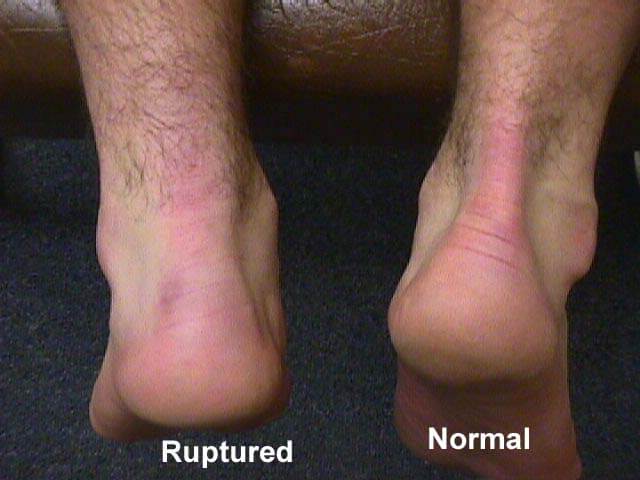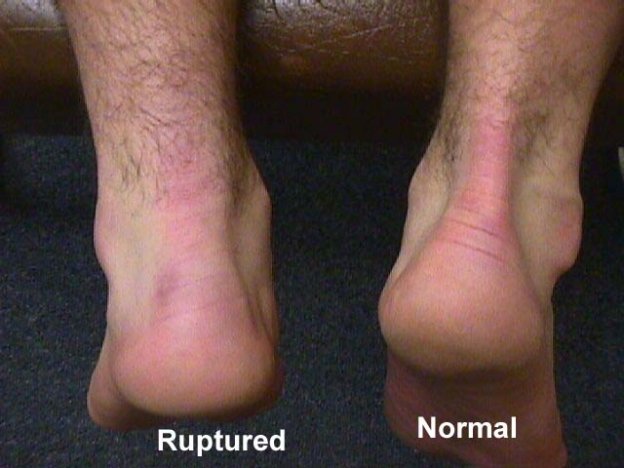Stopping Gout Together › Forums › Help My Gout! The Gout Forum › Tendinitis mimicking Gout? Or tendinitis caused by gout?
Tagged: Forum for Arthritis Sufferers
- This topic has 22 replies, 8 voices, and was last updated 3 years ago by
nobody.
-
AuthorPosts
-
-
December 10, 2017 at 8:21 pm #6107
Ken Bell
Participant
I have had a few gout attacks over the course of time.
But recently after a chest infection, I was woken with pains on top of my foot below my toes and behind my ankle. Then after about a week or so the side of my toe flared up. But the naproxen didn’t help much?
Could this be tendinitis or gout?
regards ken

Tendinitis mimicking gout? Or tendinitis caused by uric acid crystals?
-
December 13, 2017 at 2:12 am #6127
 Keith TaylorParticipant
Keith TaylorParticipantHi Ken,
That’s not much information to go on. But I’ll have a stab at answering “could this be tendinitis or gout?”
So, I’ll guess 20% chance of tendinitis and 80% chance of gout. But, if you leave it long enough without controlling your uric acid, gout will cause tendinitis. Then, you’ll have both.
-
December 13, 2017 at 3:57 pm #6144
 Jean ClyneParticipant
Jean ClyneParticipantI had Achilles tendinitis for years with thickening along sides of tendon just above the heel, would sometimes bother me a bit, but several months after going on allopurinol, the chronic thickening completely disappeared, is still gone, after having for 20 yrs plus, so I would think it has to be related, too much of a coincidence I would think. Never thought about it being related to gout.
-
December 14, 2017 at 11:09 am #6149
 Keith TaylorParticipant
Keith TaylorParticipantThat’s really interesting Jean. The “thickening” was almost certainly uric acid crystal deposits.
In future, I guess we will have routine body scans for suspected gout sufferers. Then that will show where uric acid deposits are situated around the body. It’s exciting DECT technology. But, it’s mostly limited to research facilities or expensive clinics at the moment.
So, we’re going to have to wait for easy access to DECT technology. But when it comes, it will be easy to differentiate between tendinitis mimicking gout. Or tendinitis caused by gout.
-
-
December 14, 2017 at 4:04 pm #6150
 Brad KeckParticipant
Brad KeckParticipantThere is a strong association between gout and tendinitis that is only recently well described in the medical literature. Particularly in the knee and tendons of the quadriceps, high uric acid can lead to substantial inflammation and pain. Reduction of uric acid does lead to improvement.
On a personal note, I have experienced a similar pain in the knees, which is now much improved as a result of gout management.
If you are interested, I can send some recent references.
Brad
-
December 15, 2017 at 6:53 am #6151
 Keith TaylorParticipant
Keith TaylorParticipantYes please, Brad!
I’m always interested in medical references. Especially when they help explain little known aspects of gout.
But I ask that you check first to see if I’ve already mentioned them. So please search for the study title in the gout search box near the top of every page.
Also, when you post the references, I’d love to know what you find interesting about them.
Thanks for helping fellow gout sufferers.
-
-
December 16, 2017 at 6:21 pm #6154
 Brad KeckParticipant
Brad KeckParticipantThe first article is a study of hyper uricemic gout patients compared to runners and OA sufferers. It very clearly shows the high incidence of Uric acid deposits in the tendons. This can be found in: Clin. Rheumatol., 2016 vol. 35(8) pp. 2039-2044 – “Tendon involvement in patients with gout: an ultrasound study of prevalence”
-
December 18, 2017 at 12:04 pm #6181
 Keith TaylorParticipant
Keith TaylorParticipantThanks Brad,
I’ve listed this for updating my related review of Tendon involvement in the feet of patients with gout: a dual-energy CT study. Then I noticed that suggestion box needs a good clearout. So, I’ll do that, then I’ll list the second report, and add it to the library.
-
-
December 16, 2017 at 6:31 pm #6155
 Brad KeckParticipant
Brad KeckParticipantA second article that shows the high incedence of tendon involved uric acid deposition and the clinical utility of dual energy CT is: Rev Bras Reumatol Engl Ed, 2017 vol. 57(1) pp. 64-72 “Relevant aspects of imaging in the diagnosis and management of gout”
While most MDs won’t have access to this imaging technology, it still shows they need to be aware of the high impact of gout – and the need to exclude high UA as part of any diagnosis. Seems MDs on both sides of the Atlantic are often missing this point!
-
December 17, 2017 at 5:28 pm #6160
 Jean ClyneParticipant
Jean ClyneParticipantWhere do I find these, or does a Google search bring them up? Thanks for the info.
-
December 17, 2017 at 5:43 pm #6162
 Keith TaylorParticipant
Keith TaylorParticipantHi Jean,
I’m going to respond properly to Brad’s information soon (Thank You, Brad). Hopefully tomorrow, but might be Tuesday. I will add one report to the gout library. The second report is mainly relevant to Ultrasonic Experts. But the conclusion is important:
Tendon involvement in the lower limbs in gout is very frequent,
particularly at the patellar tendon [kneecap-shin tendon], and UltraSound possesses good sensitivity and specificity for detecting intra-tendinous
tophi [uric acid crystals deposited within tendons].
-
-
January 4, 2018 at 11:55 am #6310
Tim Ricketts
ParticipantGreat thanks for this I just posted I am having an attack in my ankle and the rest of my leg gets very sore when I walk it definitely feels like tendons / ligaments I have to stop every few yards for the pain to subside. I’m sure they are also inflamed I didn’t know if it could be related but now I see it probably is.
-
April 4, 2020 at 10:58 pm #9286
 Keith TaylorParticipant
Keith TaylorParticipantIt’s interesting (for me at least) to see increasing studies of gout and tendinitis (AKA tendonitis). I think some of this is down to advances in ultrasonic scanning whereby gouty tophi deposits are easier to see. So maybe symptoms that might have been diagnosed as tendinitis in the past might now be recognized as gout.
One such recent case is:
Mülkoğlu, Cevriye, Barış Nacır, and Hakan Genç. “A Rare Presentation of Gout: Achilles Tendinopathy, Ultrasonographic Assessment.” The American Journal of the Medical Sciences 359, no. 4 (2020): 245-246.Most commonly, arthritis in the first metatarsophalangeal (MTP) joint is the classical clinical presentation of gout. In chronic stages, gouty tophus deposits may cause soft tissue damage. Monosodium urate (MSU) may accumulate not only in the joints but also in the tendons and ligaments and may cause symptoms of enthesopathy [problems from uric acid crystals where tendons attach to bones] and tendinopathy [problems from uric acid crystals in and around tendons]. Herein, we report a patient with symptoms of Achilles tendinopathy, which is very rare presentation of gout.
I think some of our experiences suggest that tendon problems with gout are not as rare as suggested here. But accurate diagnosis can be very rare unless the big toe is involved.
-
April 5, 2020 at 10:52 am #9287
nobody
ParticipantSo you are back to posting here Keith? Is that because you’re cloistered on account of that epidemic?
Anyway I also suspect that tendon problems with gout (and Achilles “tendonitis” in particular) aren’t so rare. I even had a textbook MTP1 episode diagnosed as tendonitis by a doctor who only saw me after I took a dangerously strong NSAID dose.
-
April 6, 2020 at 6:37 am #9291
 Keith TaylorParticipant
Keith TaylorParticipantThanks nobody for this and all your great contributions.
My main reason for returning to post is part of my ongoing recovery of some anxiety issues and related mental health problems that got out of hand. So it’s fantastic to get back to engaging with people. The coronavirus epidemic is hindering that engagement process in the physical world. But you’re right – it encourages me to spend more time commenting online.
The diagnosis issues drag-on despite clearer guidelines from professional rheumatology organizations around the world. But I guess that’s part of the limited time most frontline doctors get for diagnosis. Because I’ve spoken with a few doctors who complain they often have to go with their best first guess. Then rely on the patient reporting back if the problem persists. Then they can look for other diagnoses.
Unfortunately, a lot of patients lose faith. So they move on to old wives remedies.
-
-
April 6, 2020 at 10:47 am #9292
nobody
ParticipantGood luck getting your mental health issues in check then.
I’m very stably abnormal and I’m not feeling that encouragement yet. 🙂 I find it quite convenient that much of my engagement has been cancelled for the foreseeable future and unless I count professional-type emails, I think this forum is the only place I engaged with non-relatives online in a month. -
April 7, 2020 at 2:26 pm #9293
Barry J.
GuestWhy would I have a gout-like condition?
I am very confused by everything that I have seen so far…
I recently woke to horrible pain in both my foot and hand – I thought that I had had a rough sleep and broken a toe and my thumb. I went to the doctor and started going through my symptoms… I had a bit of burning pain in my finger tip and the tip of my thumb about a day before this weird awakening; and now the base of my thumb was swelling and red, my foot just under the third and fourth toes was swelling and slightly discolored. The burning was still present. I began to think that I had some sort of infection — he took x-rays and went through the symptoms again… he said it feels like gout but it doesn’t look like gout.
SO – he said to treat it for now as a set of strained tendons. Now I have a brace on my hand, walking is difficult and I am lost..
I am 38, don’t drink, in good physical condition (boxing and dancing are two of my hobbies) no one in my family has ever had gout (that I know of)– I don’t fit the profile… Is this pseudogout a possibility?
Thanks for any help that anyone can offer.
-
April 7, 2020 at 3:34 pm #9294
nobody
ParticipantThe best information you can get cheaply about whether you are at risk of developing gout symptoms is the amount of uric acid in your blood. Maybe your doctor has already ordered that test for you (perhaps you could ask their office?) considering the result is a number which matters much more than your age. If not, get tested!
Besides alcoholism, some diseases as well as some diets (in particular Atkins, paleo, keto and so forth) can also bring about gout.I assume your doctor gave you pills that target the swelling and the pain regardless of the cause. In case they don’t work well enough, perhaps you could share the details here (exact dose included) and someone might provide other drug names to discuss with your doctor or simply tips to manage your symptoms.
-
April 13, 2020 at 2:35 am #9296
Steve Wong
Participant@ Ken Bell – You mentioned at the beginning that you had a chest infection, then the gout symptoms began soon after. I too had the same issue. I took some antibiotics and then a few days later, my tendon bursa was inflamed. Podiatrist said it was gout. I had 3.5 days of uric acid cleansing, tendon bursa very slight improvement during the 3.5 days. Took a uric acid blood test showed 5.5-normal (5.9 was the upper limit for too much). After the uric acid results still w/ tendon bursa pain, I thought I didn’t have gout and might have strained the bursa. Since my uric acid was normal, I went back to my normal diet the very next day (meat/veg/rice/wine for dinner, pinto beans/meat for lunch). 5 days later, my big toe joint started to hurt like gout at which time, my tendon bursa was getting better. Now I’m in full gout attack w/ big toe pain, and going back to uric acid cleansing. Previous gout attack 1.5 years ago was induced by too much partying and drinking lots of beer (6 per day for 10 days) on vacation.
So, I think what’s happening now is that my uric acid blood test was skewed due to my 3.5 days of cleansing. What really happened *might* be that the antibiotics nuked my good bacteria. I read that the good bacteria removes some portion of uric acid, which it can’t do now. Therefore, any meat/alcohol diet is triggering a gout attack.
What do you guys think? It seems to be what’s common about Ken Bell and me.
Ken Bell – Did you take antibiotics for your chest infection prior to the gout attack? Thanks.
-
April 13, 2020 at 4:52 pm #9298
Toni Lee
GuestWhat’s a Uric acid cleans?
Sent from my iPhone
-
-
April 13, 2020 at 2:09 pm #9297
nobody
ParticipantIt’s easy to turn coincidences into causes in one’s mind when trying to explain a small number of occurrences. Without sufficient data, people typically end up developing superstitions.
One problem is that uric acid readings can be noisy even when you’re not taking antibiotics. Other drugs can affect uric acid and even if you hadn’t taken any drug, any illness might cause you to behave differently and would of course affect your metabolism.If you know for a fact you have gout, then the general advice (not applicable in every case) would be to reduce the amount of uric acid in your blood considering you are experiencing symptoms even is test results suggest it’s low enough.
If your test result was 4 mg/dl (always check the units!) it would be another matter but 5.5 isn’t quite safe. If you had numerous reliable test results all showing 5.5 or under over a long period of time, that would be grounds for doubting whether your symptoms really are caused by gout. But a single 5.5 result is too high to rule out excessive uric acid in the blood regardless of the circumstances of the test.
You may or may not be able to control your uric acid through diet alone. But you for sure ought not to assume a diet is successful based on a single test or on symptoms going away for a while (even a whole year would not be long enough to know for a fact whether your gout is getting worse or not). You’ll need many blood tests to make sure a diet is actually working.
The danger is that untreated gout typically gets worse even when you aren’t having any symptoms. You could pay today’s neglect dearly down the road. So don’t let it fester for years! The one thing that shows it is under control is test results clearly establishing uric acid is reliably low enough to cure gout.If on the other hand you merely suspect you have gout, you should still get your uric acid tested several times to determine whether gout is a likely explanation for your symptoms or not. But do not rule out other causes in the meantime and get serious symptoms checked by doctors just in case it’s actually an infection which needs to be treated or a more serious disease than gout.
-
April 13, 2020 at 7:07 pm #9299
Steve Wong
ParticipantNobody, thx for your reply.
My big toe is definitely gout. I’ve had it before there. My question really isn’t whether I have gout. I know I’m in the midst of a gout attack now.My question is: Has anyone else heard this? Since antibiotics annihilates your good/bad bacteria, is it likely that after taking antibiotics a 3 weeks ago, I am now more susceptible and easily getting gout because my non-existent good bacteria can no longer assist in removing my uric acid before it gets to the kidneys.
I say “susceptible / easily getting gout” because I’m eating the same diet as I was before taking the antibiotics. However, now, I’m on day 15 of 2 gout attacks (days 1-12 on the achilles tendon bursa, days 13-15 on the big toe joint…both same foot. First attack subsided as the second one started.
-
April 13, 2020 at 8:27 pm #9300
nobody
ParticipantYou’ll be forever chasing shadows if you try to manage gout like a disease which develops over days rather than years. If you’re having a gout attack now, it’s most likely because your uric acid was not controlled before you took the antibiotics. Every year you neglect to control it, gout typically gets worse.
-
-
AuthorPosts
The forum ‘Help My Gout! The Gout Forum’ is closed to new topics and replies.
